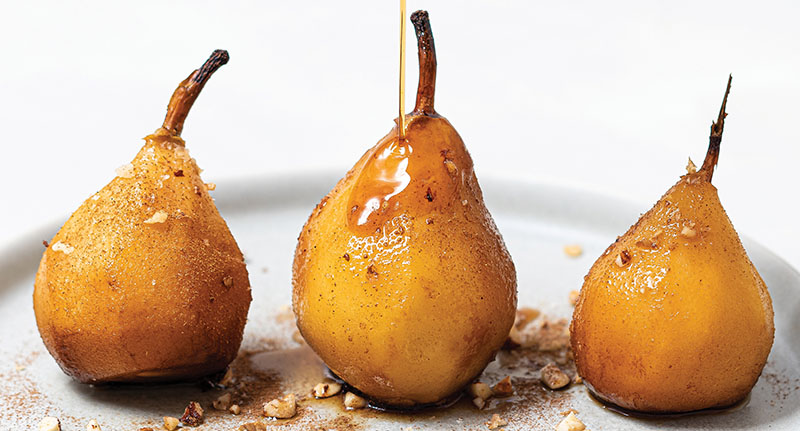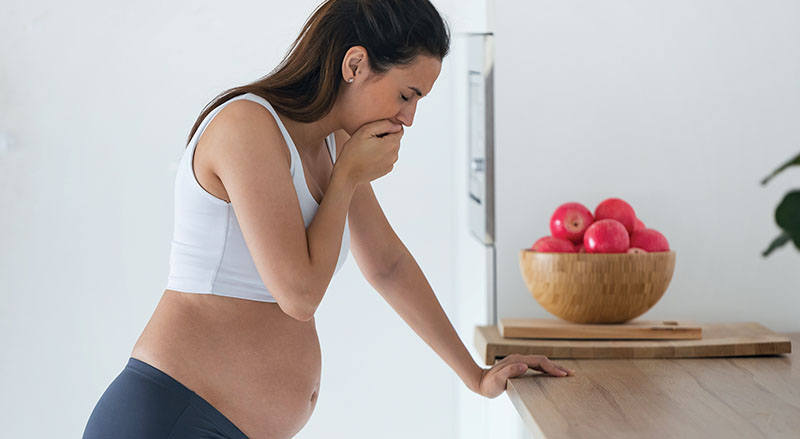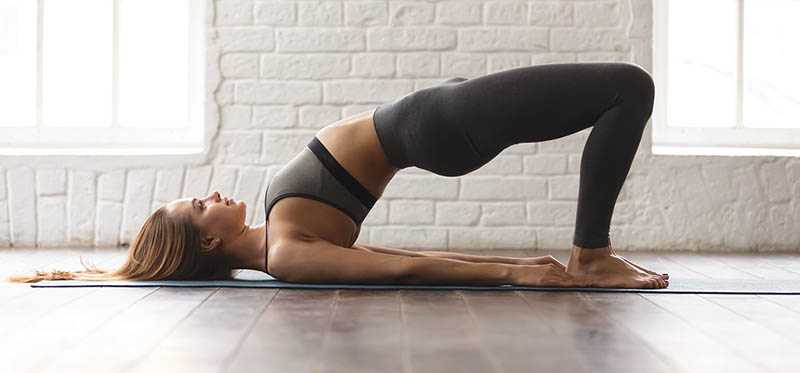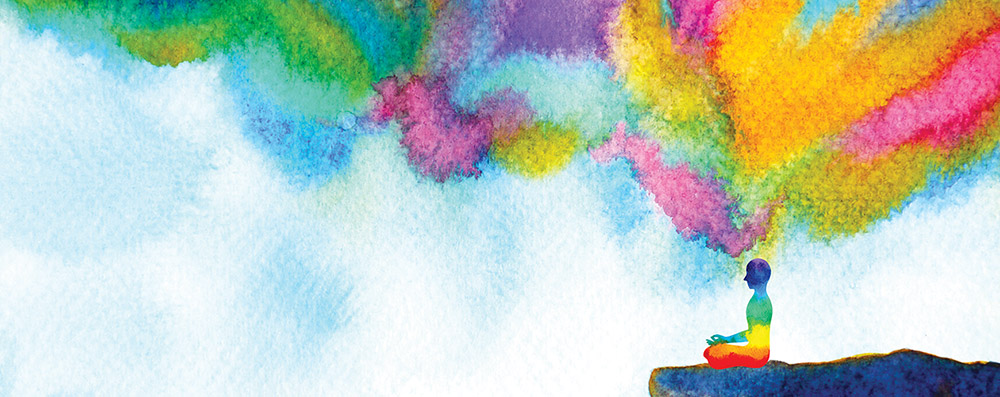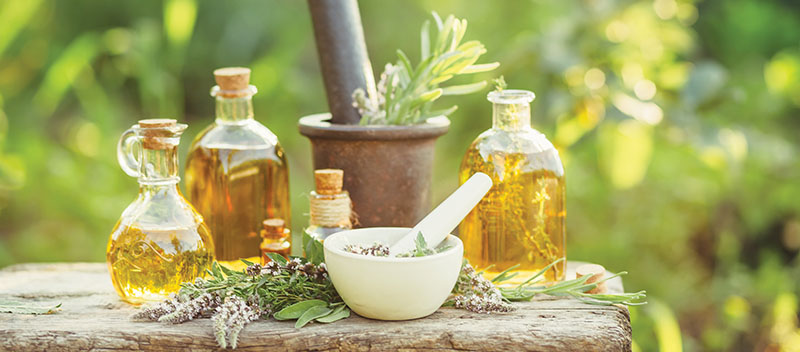Before we get into a simple yoga routine that can help us greet the new day and meet our challenges with grace, it’s important to remember to practice safely and with care. Back out of a stretch if it’s too intense and modify as necessary.
Focused breathing is key to being able to relax in yoga poses. A gentle and calming technique is called Ujjayi or ocean breath.
Inhale for 5 seconds through the nose.
With your mouth closed, exhale through your nose for 5 seconds while constricting the back of your throat, as if you’re
saying “ha”.
The inhalation and exhalation should sound like the tides of the ocean.
Hold each posture for 3 to 5 cycles of breath.
Mountain Pose
This is the foundation for all of the standing poses and improves posture and stability.
Stand up tall and bring your feet parallel.
Bring focus to your core and engage your abdominal muscles.
Feel a gentle lift through the thigh muscles.
Feel grounded through your feet.
Relax your shoulders.
Side Stretch
With an inhale, gently lift your arms overhead.
Grab your right wrist with your left hand.
Side bend to the left, giving your right wrist a gentle pull.
Come back through the center and do the opposite side.
Forward Fold
This is a very good pose to open the hamstrings, stretch the back muscles, and make the spine supple by allowing decompression of the vertebrae.
Fold forward over your thighs, hinging from the hips.
Keep a small bend in the knees.
Bring the hands to the floor, shins, or grab opposite elbows if the hamstrings are tight.
Relax the neck and shoulders.
Downward Dog
This pose stretches the shoulders, hamstrings, calves, and allows traction of the spine.
From a forward-fold, plant your hands firmly into the ground.
Step your feet back one foot at a time so that they are hips distance apart.
Lift your hips and engage your thighs while putting your weight into the heels.
Keep a small bend in your knees.
Peddle out your knees to open the calves and hamstrings.
Planks
From a downward dog position, push forward into a high push-up.
Keep your shoulders in a straight line with your wrists.
Engage your abdomen and thigh muscles.
Push your heels back for a calf stretch.
Keep a slight lift in your tailbone to protect your low back.
Relax your neck.
Cobra Pose
As a heart-opening pose, the cobra pose stretches the chest, lungs, shoulders, and abdomen. It also strengthens the spine, and promotes flexibility.
From a plank position, lower down to the floor onto your belly.
Place your palms beneath your shoulders.
Elbows tuck toward your sides.
Press your pubic bone into the floor.
For a mild backbend press into hands, leaving elbows slightly bent as you lift your head and chest away from the floor.
For a deeper backbend, push all the way up with a full extension of arms.
Puppy Pose
This pose stretches the spine, shoulder, and arms. It is a deeply relaxing stretch for the back, which also helps calm the nervous system.
From a tabletop position, walk your hands forward and sink the hips back toward the heels.
Lower the forehead to the mat and relax the neck.
Actively stretch arms forward while pulling hips toward heels.
Tiger Pose and Cross Arch Stretch
This pose is a balance and back strengthening pose. It also stretches the psoas and quadriceps muscles.
From a tabletop position, extend the right hand out in front of you.
Extend the left leg out behind you.
Engage your core.
When stable, lift the left leg off the ground.
Then draw the left knee to the right elbow and hold in an abdominal crunch position.
Release the crunch position and once again, extend the right hand out in front and left leg back behind you.
Bend the left knee while reaching around with the right hand to grab the left foot.
Repeat the sequence on the other side.
Cat-Cow Stretch
This pose releases tension in the cervical, thoracic, and lumbar spine. It also improves digestion, circulation, and relaxes the mind.
Start in a tabletop position with knees under hips and wrists under shoulders.
For cat pose, press into the hands, tuck tailbone, and round back.
For cow pose, arch the back and lift the chin and tailbone to the sky.
Low Lunge and Hamstring Stretch
This stretch improves focus, balance, and stability. It stretches your arms, legs, shoulders, neck, belly, groin, and ankles while energizing the entire body.
From a tabletop position, bring your left foot forward between your hands.
Keep the left knee at a 90-degree angle so that the knee is in line with the ankle.
Slide the right knee back on the mat until there is a comfortable stretch in the right thigh and groin.
Reach arms overhead and create
a mild back arch.
Then plant your hands on either side of the mat and sit back toward your right heel for a hamstring stretch.
Repeat to the other side.
Wide Leg Standing Forward
Fold with Clasped Hands
This stretches the hamstrings, inner thighs, deltoids, and biceps.
From a wide-legged stance, with feet parallel, bring hands to hips.
Fold forward, hinging from the hips.
Clasp hands behind you and raise them away from the sacrum.
Seated Spinal Twist
This helps stretch the spine, shoulders, and hips. It massages the internal organs, improves digestion, relieves sciatica, as well as low back and neck pain.
Sit with legs stretched out in front of you.
Pull one knee towards your body and sit up tall.
Twist slowly toward your bent knee, wrapping the opposite elbow to the outside of the bent knee.
Repeat on the opposite side.
Seated Side Stretch
Sit comfortably with one leg in front of the other or cross-legged.
Place your right hand down on the ground for support.
Extend your left arm up to the sky as you reach and bend laterally to your right.
For a deeper stretch, place your right hand on your left knee and extend your left arm up as you bend laterally to the right.
Repeat on the opposite side.
Bridge Pose
Lay down onto your back.
Feet are planted hips distance apart.
Bend knees so they are pointing upward.
Fingertips should be able to graze the backs of the heels.
Press through the feet and squeeze thighs slightly inward as you lift hips and sternum off the mat.
Clasp hands together for a deeper stretch.
Natasha Kubis is a licensed acupuncturist and certified yoga teacher.
For more information, visit acuwellhealth.com
